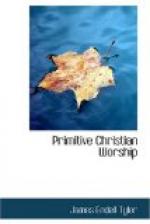The only other passage in which reference appears to be made in the Old Testament to the Mother of our Lord, contains that celebrated prophecy in the seventh chapter of Isaiah, about which I am not aware that any difference exists between the Anglican and the Roman Churches. “A Virgin shall conceive and bear a Son, and shall call his name Immanuel.” [Isaiah vii. 4.]
I find no passage in the Old Testament which can by any inferential application be brought to bear on the question of Mary’s being a proper object of invocation.
* * * * *
In the New Testament, mention by name is made of the Virgin Mary by St. Matthew, St. Mark, and St. Luke, and by St. John in his Gospel, as the Mother of our Lord, but not by name; and by no other writer. Neither St. Paul in any one of his many Epistles, though he mentions the names of many of our Lord’s disciples, nor St. James, nor St. Peter, who must often have seen her during our Lord’s ministry, nor St. Jude, nor St. John in any of his three Epistles, or in the {274} Revelation (though, as we learn from his own Gospel, she had of especial trust been committed to his care)—no one of these either mentions her as living, or alludes to her memory as dead.
The first occasion on which any reference is made in the New Testament to the Virgin Mary is the salutation of the Angel, as recorded by St. Luke in the opening chapter of his Gospel. The last occasion is when she is mentioned by the same Evangelist, as “Mary the Mother of Jesus,” in conjunction with his brethren and with the Apostles and the women all continuing in prayer and supplication, immediately after the ascension of our blessed Lord. Between these two occasions the name of Mary occurs under a variety of circumstances, on every one of which we shall do well to reflect.




